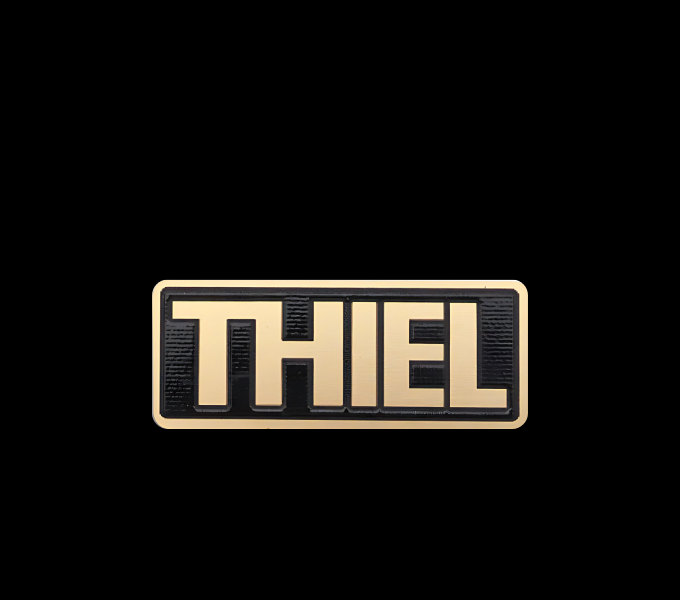Thiel

Brand History
Echoes of Accuracy: The Rise, Fall, and Enduring Legacy of Thiel Audio
In the hallowed halls of high-fidelity audio, certain names resonate with a unique blend of reverence and nostalgia. Thiel Audio is undoubtedly one of them. For decades, the Lexington, Kentucky-based company was synonymous with sonic purity, innovative engineering, and an unwavering dedication to reproducing music with uncanny realism. Yet, like a final, fading note, Thiel ceased operations in 2018, leaving behind a dedicated following and a legacy etched in the principles of time and phase coherence.
The Genesis of Genius: Phase and Time
Founded in 1976 (though formally incorporated in 1977) by the visionary engineer Jim Thiel, along with his partner Kathy Gornik who handled the business side, Thiel Audio wasn’t just another speaker company. It was built on a foundation of rigorous acoustic principles, primarily Jim Thiel’s relentless pursuit of time and phase coherence.
What did this mean? In simple terms, Thiel believed that for a speaker to sound truly realistic, all frequencies (lows, mids, highs) produced by the different drivers must arrive at the listener’s ears at precisely the same time (time coherence) and in perfect alignment (phase coherence). This sounds logical, but achieving it is an engineering nightmare.
It required complex solutions:
- First-Order Crossovers: Thiel famously employed simple first-order crossover networks. While electrically simple, they demand drivers capable of operating smoothly well beyond their primary frequency range and necessitate careful physical driver alignment.
- Sloped Baffles: The iconic sloped front baffle seen on many Thiel models wasn’t just for aesthetics. It physically aligned the acoustic centers of the woofer, midrange, and tweeter, ensuring sound waves from each reached the listener simultaneously.
- Custom Drivers: Off-the-shelf drivers often couldn’t meet Thiel’s demanding requirements. The company frequently designed and sometimes even manufactured its own bespoke drivers, optimized for phase accuracy and smooth response within their specific crossover scheme.
The Thiel Sound: Clarity and Challenge
The result of this meticulous engineering was a characteristic “Thiel sound.” It was lauded for its exceptional clarity, transparency, pinpoint imaging, and startling dynamic realism. Instruments and voices emerged from a deep, stable soundstage with lifelike presence. Thiel speakers weren’t just playing music; they were attempting to reconstruct the original acoustic event.
This accuracy, however, came with demands. Thiel speakers were notoriously revealing of upstream components and recordings. Poor source material or inadequate amplification would be laid bare. Their unique crossover design often presented amplifiers with challenging impedance loads, requiring robust power supplies to make them truly sing. They weren’t always “easy listening” in the traditional sense, but for audiophiles seeking unvarnished truth, they were revelatory.
Models like the CS1, CS2 (and its many variants like the 2.2, 2.3, 2.4), the legendary CS3 series (culminating in the highly regarded CS3.7), and the flagship CS7 became benchmarks in the high-end audio world throughout the 1980s, 90s, and 2000s. Each speaker was a testament to Jim Thiel’s evolving design philosophy, meticulously crafted in Lexington with impressive build quality and often beautiful wood finishes.
The Turning Point and Eventual Silence
The high-end audio landscape is tough, but Thiel navigated it successfully for decades under the synergistic leadership of Jim Thiel’s engineering prowess and Kathy Gornik’s business acumen. A devastating blow came in 2009 with the passing of Jim Thiel from cancer. He was the sonic soul of the company, the source of its unique design DNA.
While the company continued, releasing designs Jim had been working on, the driving creative force was gone. In 2012, Kathy Gornik sold Thiel Audio to a private equity firm based in Nashville, Tennessee. The subsequent years saw attempts to modernize and potentially broaden the brand’s appeal, including relocating operations to Nashville and exploring different product categories.
However, recapturing the magic and market position established under Jim Thiel proved incredibly difficult. The core identity, deeply intertwined with its founder’s specific vision and Kentucky roots, seemed diluted. For many loyalists, the post-Jim Thiel era represented a departure from the principles that made the brand special. Facing mounting challenges in a rapidly evolving market, Thiel Audio ceased operations entirely in 2018.
The Legacy: More Than Just Speakers
Though Thiel Audio is no more, its influence persists. Jim Thiel’s relentless focus on time and phase coherence pushed the industry forward, making these concepts more widely understood and pursued by other designers. Thiel speakers remain highly sought after on the used market, cherished by audiophiles who appreciate their unique blend of accuracy, detail, and musicality.
Thiel Audio stands as a reminder of an era when high-end audio was often driven by singular visions and uncompromising engineering principles. It represents the pursuit of an ideal – perfect sound reproduction – achieved through innovation, dedication, and a deep understanding of acoustic science. The company may be silent, but the echoes of its accurately rendered notes continue to resonate within the audio community.
